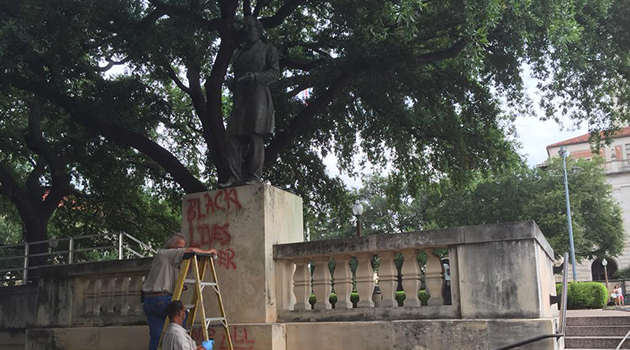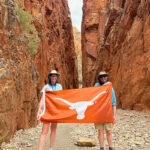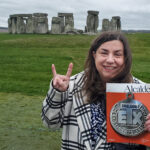TXEXplainer: Confederate Statues on Campus
On Wednesday, UT president Greg Fenves announced the formation of a task force charged with determining the future of the Jefferson Davis statue that overlooks the South Mall from its northwest corner, as well as statues of other Confederate leaders. The statue of Davis, the first and only president of the Confederate States of America, has been controversial since it was first proposed, and recent events highlighting the lingering scars of slavery and racial inequality have amplified the chorus of voices calling for its removal.
Here’s what we know about the Confederate statues on campus and the commission that may decide their fate.
Who’s on the task force?
The group, formally called the Task Force on Historical Representation of Statuary at UT-Austin, is composed of current student leaders, faculty members, administrators, and alumni. Here are the members, as announced last week:
Gregory J. Vincent, Vice President for Diversity and Community Engagement (chair)
Laura Beckworth, JD ’83, Life Member, Chair of UT-Austin Development Board
Daina Berry, Associate Professor, Departments of History and African and African Diaspora Studies
Hector de Leon, BS ’70, JD ’73, Life Member, Distinguished Alumnus, past president of both the UT Law Alumni Association and the Texas Exes
Edmund “Ted” Gordon, Chair, Department of African and African Diaspora Studies
Rohit Mandalapu, Vice President, Student Government; Senior, College of Liberal Arts
Carlos Martinez, Associate Vice President for Governmental Relations
Lorraine Pangle, Co-director, Thomas Jefferson Center for the Study of Core Texts and Ideas; Professor, Department of Government
Xavier Rotnofsky, President, Student Government; Senior, College of Liberal Arts
Frederick “Fritz” Steiner, Dean, School of Architecture
Marisa Swanson, President, Social Work Council; Member, Senate of College Councils; Senior, School of Social Work and College of Liberal Arts
Brian Wilkey, President, Graduate Student Assembly; Graduate Student, College of Natural Sciences
What are they supposed to be determining?
Fenves is essentially asking for a list of possible options for the historic statuary on the Main (or South) Mall, along with pros and cons for each option regarding how different campus constituencies might react. The task force’s guidelines also stress the artistic and historical meaning of the statues, and their own history on the Forty Acres “with particular focus on the statue of Jefferson Davis.”
Here’s the official to-do list:
Analyze the artistic, social, and political intent of the statuary on the Main Mall, with particular focus on the statue of Jefferson Davis, as well as the historical context that they represent.
Review the previous controversies over the Main Mall statues and factors that are similar and different today.
Develop an array of alternatives for the Main Mall statues, particularly the statue of Jefferson Davis, with special attention to artistic and historical factors considering the university’s role as an educational and research institution. In providing alternatives, a discussion of the pros and cons for each alternative from the perspective of students, faculty, alumni, and other important campus constituencies will be particularly useful.
Is this a new debate?
Far from it. The statue has drawn criticism since before it was even constructed (more on that in a moment). And this isn’t the first time a task force has looked into it, either: In 2003, then-UT president Larry Faulkner commissioned a Task Force on Racial Respect and Fairness, which issued a report on the statue as well as other race-related campus controversies.
Faulkner noted that the Davis statue was originally designed to be part of a group of several Confederate and Union figures, but that the plans were changed so that the statues ended up scattered across the mall, which took them out of context. “Each statue became, by default, an isolated representation of the depicted individual, with no clear theme underlying the selection of individuals,” Faulkner said. He proposed uniting them as sculptor Pompeo Coppini originally intended, but that never happened.
There’s more than one controversial statue?
While the statue of Davis, the most important Confederate enshrined in bronze, is certainly at the center of the debate, other statues of Confederates line the mall.
A statue of John H. Reagan, leaning on a cane, hat in hand, stands near Mezes Hall. Reagan, the namesake of Austin’s Reagan High School and the Reagan State Office Building on the Capitol grounds, was the postmaster general of the Confederacy. After the war, he urged his fellow Texans to cooperate with the federal government, renounce secession, and allow freed slaves to vote.
Albert Sidney Johnston stands by Calhoun and Parlin Halls. Johnston, the former namesake of what is now Eastside Memorial High in Austin, fought in the Texas Revolution and the Mexican-American War before serving in the Confederate Army. He was killed in the Battle of Shiloh, likely by friendly fire. He was the highest-ranking officer killed in action on either side of the war.
Johnston was succeeded as the darling of the Confederacy by Virginian Robert E. Lee, who is also represented in bronze.
Why is there a statue of Jefferson Davis on campus anyway?
The short answer is that George Washington Littlefield—prominent rancher, banker, donor, Confederate soldier, and UT regent—wanted one, and he donated the money to make it happen.
But the short answer isn’t as interesting as the longer version. It involves Littlefield and a rival regent, also named George Washington. In 1910, George Washington Brackenridge donated 500 acres along the Colorado River, now called the Brackenridge Tract. Many supported moving the university from its current location to the roomier tract, but Littlefield, whose Victorian home sat across the street from campus (now firmly in the middle of campus), opposed it.
Littlefield was committed to Texas and the South. Brackenridge, a northerner, was more committed to education. Robert Vinson was UT’s president from 1916-22, and summed up the animosity between the two succinctly: “When Mr. Brackenridge spoke of the University of Texas, he emphasized the word University. Major Littlefield emphasized the word Texas.”
With the end of World War I, enrollment was climbing, and Littlefield sought to keep the campus from moving by donating a massive gateway to campus. His idea eventually became the Littlefield Fountain and South Mall we know today. But Pompeo Coppini, the Italian-American sculptor hired for the project, warned against Littlefield’s initial plan to create a memorial to the Confederacy.
“As time goes by, they will look to the Civil War as a blot on the pages of American history,” Coppini argued, “and the Littlefield Memorial will be resented as keeping up the hatred between the Northern and Southern states.”
Coppini’s vision was of a memorial to those who fought in the World War, and two obelisks bracketing the main plaza would represent the North and the South, one with Davis in front, one with the more recent wartime president, Woodrow Wilson, showing the unity of North and South.
In 1920, just after regents agreed to Coppini’s plan, Littlefield died—but not without ensuring that Brackenridge wouldn’t push to move the university after Littlefield was gone. He included $250,000 for the memorial, plus another $800,000 for other projects, in his will, contingent on the university staying put for eight years.
Still, many supported moving the campus to the riverfront. But when the bill moved in the legislature, lawmakers added a provision that any locality with the space and the money to do so could vie for the campus, and that a statewide vote would determine the winner. The move’s original supporters turned against the new plan, and the bill was defeated. Littlefield got his wish.
It took 10 years for the bronze work to be completed, and by then, Paul Cret had been brought on to create the master plan that now defines the heart of campus, including the Main Building and the “six pack” along the South Mall. Coppini’s obelisks were cut from the plan to save money, and Cret moved the statues meant to surround the memorial up onto the Mall to give them more space. Coppini was very unhappy with the result, and the rest, as they say, is history.
UT employees remove graffiti from the Jefferson Davis statue last week. Photo by Matthew Watkins via Twitter.


















No comments
Be the first one to leave a comment.